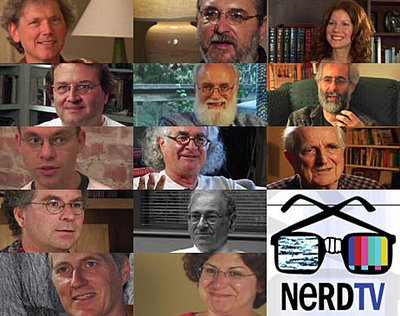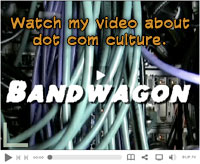My Deep Zoom Comic and a Busted Narrative Structure

How is Narrative Structure Influenced by Presentation Format?
I just drew a comic about something that happened to me in the dot com days. I've posted it online in three different formats, partially because I wanted to see how different forms of presentation might change the overall feel of the story. I like the Silverlight Deep Zoom version the best by far. It allows the reader to scroll left and right and up and down. Plus it allows the reader to zoom deep into the image, seeing all the detail and even finding images within images. This "resolution independence" has allowed authors and creators to create unique new modes of storytelling.
Does it destroy the integrity of the story line and plot? You tell me. Perhaps our scattered, divergent, web-era minds crave stories where multiple plot paths intersect and overlap. It's often how we read the web, leaping from story to link to picture and back. Are these narrative asides just bad habits of an internet-infected mind? I actually think that, done well, these techniques can free creators to tell a multi-dimensional story like never before.
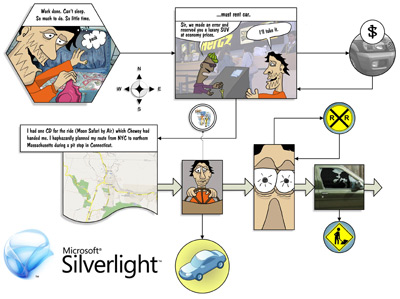 Above is the Microsoft Silverlight Deep Zoom version. This allowed me to tell the story the way I really wanted to. It allows for the best resolution and easiest user controls. Hover over the image and you'll see the controls to zoom in and out. You should also be able to use your scroll wheel. Go Full Screen!
Above is the Microsoft Silverlight Deep Zoom version. This allowed me to tell the story the way I really wanted to. It allows for the best resolution and easiest user controls. Hover over the image and you'll see the controls to zoom in and out. You should also be able to use your scroll wheel. Go Full Screen! Don't miss the hidden images. Some are easy to find, but some are much harder. The whole "resolution independence" of Deep Zoom allowed me to overlay images. If the reader zooms into a tiny spec on a photo, that spec may reveal a full-resolution photo that itself can be zoomed into. Theoretically infinite.
Don't miss the hidden images. Some are easy to find, but some are much harder. The whole "resolution independence" of Deep Zoom allowed me to overlay images. If the reader zooms into a tiny spec on a photo, that spec may reveal a full-resolution photo that itself can be zoomed into. Theoretically infinite.Find the following hidden images:
- A Thai food menu.
- Three pictures of Hawaii.
- Another entire comic.
- A pixel farmer farming pixels.
- A spreadsheet.
- Tripod.com home page.
- A picture of me during the dot com days yelling at a phone.
You'll need the Silverlight plug-in which is a very quick install.
Sorry, I can't get it to work on the Mac yet. Silverlight is totally cross-browser and cross-platform, but the Deep Zoom composer tool is still a young product and the output is not fully optimized (which means a lot of tweaking of the XAML which I'm not an expert with.)
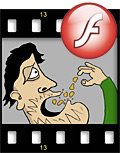 This is the Flash version. I bet with a little extra work I could simulate the Deep Zoom effect, but I'm just not a Flash guru. I want to spend time making stories and not doing multimedia development. This version works pretty good, but it forces the reader into one linear path.
This is the Flash version. I bet with a little extra work I could simulate the Deep Zoom effect, but I'm just not a Flash guru. I want to spend time making stories and not doing multimedia development. This version works pretty good, but it forces the reader into one linear path. 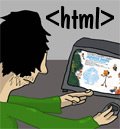 This is the HTML version. This is so old school! Just some big-ass JPEGs stuck in a table (about 4.5 meg). I like this because it is simple and it works cross-browser, but ultimately it's kind of a pain in the butt to scroll around using the browser controls...too much effort.
This is the HTML version. This is so old school! Just some big-ass JPEGs stuck in a table (about 4.5 meg). I like this because it is simple and it works cross-browser, but ultimately it's kind of a pain in the butt to scroll around using the browser controls...too much effort.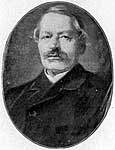 All this makes me think about traditional narrative structure and the "The Freytag Pyramid." Gustav Freytag was the German writer who described a system for dramatic structure back in 1863. It's a mighty nice structure and I use it often. But, I also strive to bust that sucker up.
All this makes me think about traditional narrative structure and the "The Freytag Pyramid." Gustav Freytag was the German writer who described a system for dramatic structure back in 1863. It's a mighty nice structure and I use it often. But, I also strive to bust that sucker up.
Check out the recent Wired magazine article by Scott Brown called "Why Hollywood Needs a New Model for Storytelling" to learn about Freytag deviants.
If you like this stuff, then check this out:
Video Below: Scott McCloud, graphic novel guru, talks about infinite canvases and digital comics at the TED conference.
 This is an ancient interactive story I made back in the mid-90s. I was experimenting with the choose-your-own-ending storybook concept.
This is an ancient interactive story I made back in the mid-90s. I was experimenting with the choose-your-own-ending storybook concept. Download Microsoft Deep Zoom composer and make your own infinite canvases.
Download Microsoft Deep Zoom composer and make your own infinite canvases. Learn how Deep Zoom works here and here.
View more of my dot com comics.
Labels: comic, digital+storytelling, fun, history, internet+history, internet+industry, MountainZone, Silverlight

